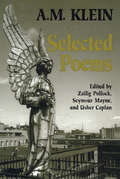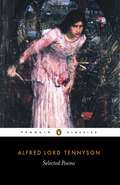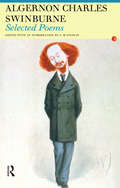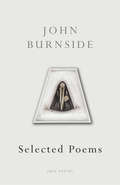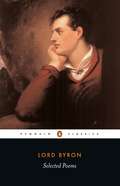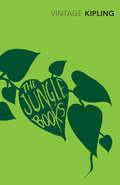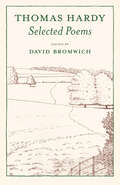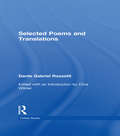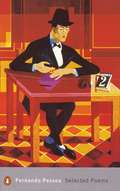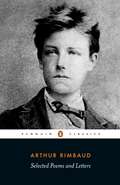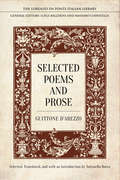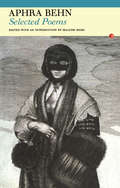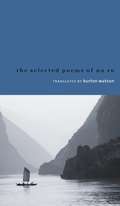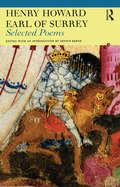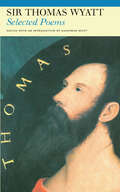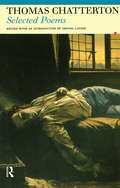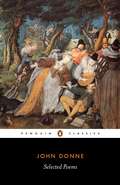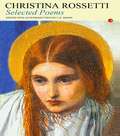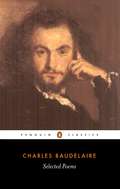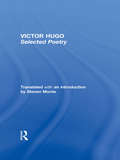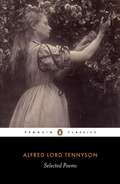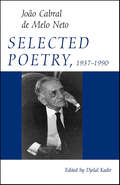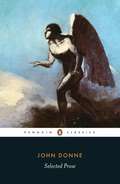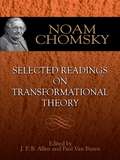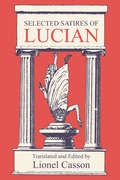- Table View
- List View
Selected Poems
by Seymour Mayne A. M. Klein Zailig Pollock Usher CaplanThroughout his career A.M. Klein struggled to define for himself the role of the poet in the contemporary world. Deeply rooted in the traditions of Judaism, and at the same time powerfully attracted by the freedom and scope of international modernism, he sought to reconcile past and present, community and creative individuality. Whether or not he finally achieved his own high aims, it was, in his own words, 'something merely to entertain them.' The result was a body of work immensely rich and varied in tone, language, cultural resonance.This collection of eighty-four poems offers a representative sampling of Klein's finest poetry, while taking into account the changing critical discourse of the last fifty years. Anyone interested in experiencing the full range of Klein's poetic achievement, or in understanding the complex nature of the poet, need look no further than this eminently readable volume.
Selected Poems
by Alfred Lord Tennyson'Tennyson', wrote T. S. Eliot, 'has the finest ear of any English poet since Milton,' and his verse remains unrivalled in its combination of verbal richness, emotional depth and intellectual engagement. Tennyson drew on classical and medieval legends in poems like 'The Lotos-Eaters' (1832) and 'The Lady of Shalott' (1832) to explore the spiritual tensions of the nineteenth century. In one of the great works of his maturity, 'In Memoriam' (1850) - written after the loss of his dearest friend - Tennyson vividly negotiated contemporary scepticism and the modern sciences of geology and evolution. Similar ground is covered in a dramatically darker mood in 'Maud' (1855), a poignant account of psychological disintegration.
Selected Poems
by Algernon Charles SwinburneFirst published in 2003. Routledge is an imprint of Taylor & Francis, an informa company.
Selected Poems
by John BurnsideOver seventeen years and nine collections, John Burnside has built - in the words of Bernard O'Donoghue - 'a poetic corpus of the first significance', a poetry of luminous, limpid grace. His territory is the no-man's-land of threshold and margin, the charmed half-light of the liminal, a domestic world threaded through with mystery, myth and longing. In this Selected Poems we can see themes emerge and develop within the growing confidence of Burnside's sinuous lyric poise: the place of the individual in the world, the idea of dwelling, of home, within that community, and the lure of absence and escape set against the possibilities of renewal and continuity.This is consummate, immaculate work born out of a lean and agile craftsmanship, profound philosophical thought and a haunted, haunting imagination; the result is a poetry that makes intimate, resonant, exquisite music.
Selected Poems
by Lord ByronDescribed as 'Mad, bad and dangerous to know' by one of his lovers, Lady Caroline Lamb, Lord Byron was the quintessential Romantic. Flamboyant, charismatic and brilliant, he remains almost as notorious for his life - as a political revolutionary, sexual adventurer and traveller - as he does for his literary work. Yet he produced some of the most daring and exuberant poetry of the Romantic age, from 'To Caroline' and 'To Woman' to the satirical English Bards and Scotch Reviewers, his exotic Eastern tales and the colourful narrative of Childe Harold's Pilgrimage, the work that made him famous overnight and gave birth to the idea of the brooding Byronic hero.
Selected Poems
by Matthew SweeneyRepresenting the best of ten books and twenty years' work, Matthew Sweeney's Selected Poems is a magical mystery tour into his strange, unsettling world. Readers familiar with his poetry will be used to being led astray by his cordial, confiding wit, ambushed by his sinister twists, taken in by his intimate, untrustworthy narrators. Those who are coming to the work for the first time may feel a measure of alarm and disquiet at the way the poems shift - almost without your noticing - from a fireside chat to a tale of terror, from the commonplace to the hallucinatory, from the surprisingly real to the really surprising. These are the secret, spiky narratives from the arch story-teller, the mixer of hilarity and menace, the past-master of fractured realism. The world would be a poorer place without these oblique but oddly lucid poems from Matthew Sweeney's haunted imagination.
Selected Poems
by Thomas HardyA generous selection of poems by a major Victorian writer, a virtuoso of traditional forms who came to be recognized as a uniquely inventive and original voice in modern poetry This selection of poems by Thomas Hardy (1840–1928), edited by David Bromwich, covers the range of Hardy’s extraordinary work: songs, ballads, and sonnets, dramatic monologues and elegies, along with poems that mark epochal events, such as the end of the Great War. This selection shows why Hardy has been admired as the most inward and personal of the moderns, yet also the most accessible and widely read. Included here is the full and integral text of Chosen Poems of Thomas Hardy, the final selection of his own work that Hardy chose to publish. Bromwich has selected more than one hundred fifty additional poems that cover the length of Hardy’s career, from Wessex Poems to Winter Words. His critical and biographical introduction sets Hardy’s achievement in the context of a career in prose and poetry that has no parallel.
Selected Poems (Fyfield Books)
by Dante Gabriel RossettiFor critics like John Ruskin and Walter Pater, Dante Gabriel Rossetti (1828-1892) was one of the great creative figures of the day, a painter and a poet of major stature. Yeats and the young Pound regarded him as an exemplary figure of solitary dedication to art and beauty. He called the sonnet 'a moment's monument', and his best short lyrics are instants of oppressed emotion cut free of time. In this, as in the suggestiveness of his imagery, he anticipates the French Symbolists. He can also be regarded as the founder of modern verse translation, not only for the freshness of his versions but also for his choice of poets---Villon, Cavalcanti and the young Dante. In this selection, Clive Wilmer has made a personal choice, emphasizing the 'pure poetry' of the lyrics at the expense of the more conventionally Victorian monologues and narratives. He has also included a generous selection from the translations, and provided a biographical and critical introduction.
Selected Poems (Penguin Modern Classics)
by Fernando PessoaThe writing of Fernando Pessoa reveals a mind shaken by intense inner suffering. In these poems he adopted four separate personae: Alberto Caeiro, Alvaro de Campos, Ricardo Reis and himself, using them to express 'great swarms of thought and feeling'. While each personae has its own poetic identity, together they convey a sense of ambivalence and consolidate a striving for completeness. Dramatic, lyrical, Christian, pagan, old and modern, Pessoa's poets and poetry contribute to the 'mysterious importance of existence'.
Selected Poems and Letters
by Arthur RimbaudA phenomenonally precicious schoolboy, Rimbaud was still a teenager when he became notorious as Europe's most shocking and exhilarating poet. During his brief 5-year reign as the enfant terrible of French literature he produced an extraordinary body of poems that range from the exquisite to the obsene, while simultaneously living a life of dissolute excess with his lover and fellow poet, Verlaine. At the age of 21, he abandonned poetry and travelled across Europe before settling in Africa as an arms trader. This edition sets the two sides of Rimbaud side by side with a sparkling translation of his most exhilarating poetry and a generous selection of the letters from the harsh and colourful period of his life as a colonial trader.
Selected Poems and Prose
by Antonello Borra Guitonne D'ArezzoGuittone d’Arezzo (ca. 1230-1294) was the most important, prolific, and influential poet and prose writer of the thirteenth century. Unfortunately, his work has been overshadowed by his successor; the more learned and gifted Dante Alighieri. The poems and prose included in this volume are emblematic of the two phases of Guittone’s career: he first achieved fame as a secular love poet but following his conversion in the 1260s he became a renowned religious poet. Guittone’s artistic reputation commanded the highest respect. Even Dante’s beloved Guinizzelli and Cavalcanti never enjoyed any such fame in their lifetime. Antonello Borra presents a critical introduction to Guittone’s works with a selection of his poems and letters in facing-page Italian and English translation. While Dante repeatedly condemned Guittone, recent scholarship has re-evaluated his importance and placed his work in the context of his predecessors, the Provençal troubadours and the poets of the Sicilian school. This latest volume in the Lorenzo Da Ponte Italian Library contains the first significant edition of Guittone’s works available in English translation.
Selected Poems of Aphra Behn: Selected Poems (Fyfield Bks.)
by Aphra BehnThis book presents a collection of the poetry of the 17th-century writer Aphra Behn. It examines the relationships between the sexes, seen from the woman's point of view. The book also includes some of Behn's translations, occasional pieces, satires, and songs.
Selected Poems of Du Fu (Translations from the Asian Classics)
by Burton WatsonDu Fu (712–777) has been called China's greatest poet, and some call him the greatest nonepic, nondramatic poet whose writings survive in any language. Du Fu excelled in a great variety of poetic forms, showing a richness of language ranging from elegant to colloquial, from allusive to direct. His impressive breadth of subject matter includes intimate personal detail as well as a great deal of historical information—which earned him the epithet "poet-historian." Some 1,400 of Du Fu's poems survive today, his fame resting on about one hundred that have been widely admired over the centuries. Preeminent translator Burton Watson has selected 127 poems, including those for which Du Fu is best remembered and lesser-known works.
Selected Poems of Henry Howard, Earl of Surrey (Fyfield Bks.)
by Dennis KeeneThis book is a collection of selected poems of Henry Howard, the Earl of Surrey, who is revealed as subtle and graceful poet and a translator whose vigorous and faithful versions of the Aeneid continue to enrich the literary tradition.
Selected Poems of Sir Thomas Wyatt: Selected Poems (Fyfield Books)
by Sir Thomas WyattFirst published in 2003. Routledge is an imprint of Taylor & Francis, an informa company.
Selected Poems of Thomas Chatterton (Fyfield Bks.)
by Grevel LindopThis book presents Thomas Chatterton's selected poems. It includes introductions to Chatterton's life, technique, and reputation, and shows the historical significance and unexpected range of his poetry, which spans the genres of satire, elegy, lyric, narrative verse, and poetic drama.
Selected Poems: Donne
by John DonneRegarded by many as the greatest of the Metaphysical poets, John Donne (1572-1631) was also among the most intriguing figures of the Elizabethan age. A sensualist who composed erotic and playful love poetry in his youth, he was raised a Catholic but later became one of the most admired Protestant preachers of his time. The Selected Poems reflects this wide diversity, and includes his youthful Songs and Sonnets, epigrams, elegies, letters, satires, and the profoundly moving Divine Poems composed towards the end of his life. From joyful poems such as 'The Flea', which transforms the image of a louse into something marvellous, to the intimate and intense Holy Sonnets, Donne breathed new vigour into poetry by drawing lucid and often startling metaphors from the world in which he lived. His poems remain among the most passionate, profound and spiritual in the English language.
Selected Poems: Selected Poems (Fyfield Books)
by Christina RossettiFirst published in 2002. Routledge is an imprint of Taylor & Francis, an informa company.
Selected Poems: Selected Poems And Prose
by Charles-Pierre BaudelaireThe poems of Charles Baudelaire are filled with explicit and unsettling imagery, depicting with intensity every day subjects ignored by French literary conventions of his time. 'Tableaux parisiens' portrays the brutal life of Paris's thieves, drunkards and prostitutes amid the debris of factories and poorhouses. In love poems such as 'Le Beau Navire', flights of lyricism entwine with languorous eroticism, while prose poems such as 'La Chambre Double' deal with the agonies of artistic creation and mortality. With their startling combination of harsh reality and sublime beauty, formal ingenuity and revolutionary poetic language, these poems, including a generous selection from Les Fleurs du Mal, show Baudelaire as one of the most influential poets of the nineteenth century.
Selected Poems: Selected Poetry In French And English (Fyfield Books)
by Victor HugoThis generous, varied selection of poems by one of France's best-loved and most reviled poets is presented with facing originals, detailed notes, and a lively introduction to the author's life and work. Steven Monte presents more than eighty poems in translation and in the original French, taken from the earliest poetic publications of the 1820's, through collections published during exile, to works published in the years following Hugo's death in 1883. The introduction provides helpful background information about Hugo's life and work, the selection, and what is involved in translating a poet whose effortless rhymes are central to the poetry's power. Detailed notes at the back of the volume offer information about the poems and their publishing and historical contexts. This is an ideal introduction to a poet whose work, for all its renown, remains for Anglophone readers undiscovered.
Selected Poems: Tennyson
by Alfred Lord TennysonTennyson's poetry epitomizes the Victorian age, for which he became a spokesman. His finest poems are often steeped in a sensuous melancholy, as in Maud, or are chivaric, heroic and allegorical, as in The Lady of Shalot and Morte d'Arthur.
Selected Poetry, 1937–1990 (Wesleyan Poetry Series)
by João MeloThis bilingual anthology brings together a representative selection from more than a half century of this distinguished Brazilian poet's lifetime work. Along with previously translated poems are many others in English for the first time. The remarkable group of poets and translators includes Elizabeth Bishop, Alastair Reid, Galway Kinnell, Louis Simpson, and W. S. Merwin.
Selected Prose
by John DonneThis selection of John Donne's most powerful prose shows that the man remembered predominantly for his poetry was also a preacher, and a prose writer of extraordinary power. In it, he explores the metaphysical collision between poetry and religion, suicide and duty, the secular and the spiritual that characterized his times.Edited with an introduction and notes by Neil Rhodes.
Selected Readings on Transformational Theory
by Noam Chomsky Paul Van Buren J. P. AllenThese cogent essays on linguistic theory explore Noam Chomsky's influential concept of generative grammar. The readings form a coherent outline of transformational theory, the distinguished author and educator's controversial challenge to structural linguistics. They rely chiefly on Chomsky's own words, but their arrangement is such that nonspecialists will have no difficulty in following the text. Topics include syntactic structure, features, and categories; phonology, syntax, and semantics; language acquisition; and the implications of transformational theory for language teaching. The father of modern linguistics, Noam Chomsky is Professor Emeritus of Linguistics at the Massachusetts Institute of Technology and a world-renowned philosopher, political activist, author, and lecturer. The least expensive edition of his selected readings, this volume is an ideal choice for students and teachers.
Selected Satires of Lucian
by Lionel CassonThe unsurpassed satirist of the ancient era was a young Syrian named Lucian, who, writing in Greek in the second century a.d., combined wit, irony, fearless candor, and exuberant comic fantasy to create the triumphantly irreverent dialogues and stories contained in this book. His genial mockery, aimed at man's omnipresent feelings, has never gone out of date. The jabs he gave the hypocrites; grandstanders, fakers and boobs of the ancient world can just as appropriately be administered to their counterparts in the modern world.Lucian's most typical genre is a parody of a Platonic dialogue, in which Zeus, Hermes, Eros, and other Olympians jabber in undivine harassment as some clever mortal (who very much resembles Lucian) is about to make scandalous fools of them. He also excelled at straight narrative, his two most famous tales being the elaborate science fiction spoof; "A True Story," and an old folk tale retold outrageously, "Lucius the Ass." His works were the product of an unrelentingly rational and skeptical mind, and have had an incalculable effect on writers and painters through the ages.Until this volume, the English language reader of today to appreciate the importance and intelligence of Lucian. No volume of representative selections in translation is in print. There are satisfactory versions of the complete works, but the reader who takes this long will most likely lose a good deal of the sting of Lucian's needle. Lionel Cassen also illustrates the full range of Lucian's subject matter and various literary forms and when translating tried to focus on the Greek spirit as opposed to the literal meaning.
